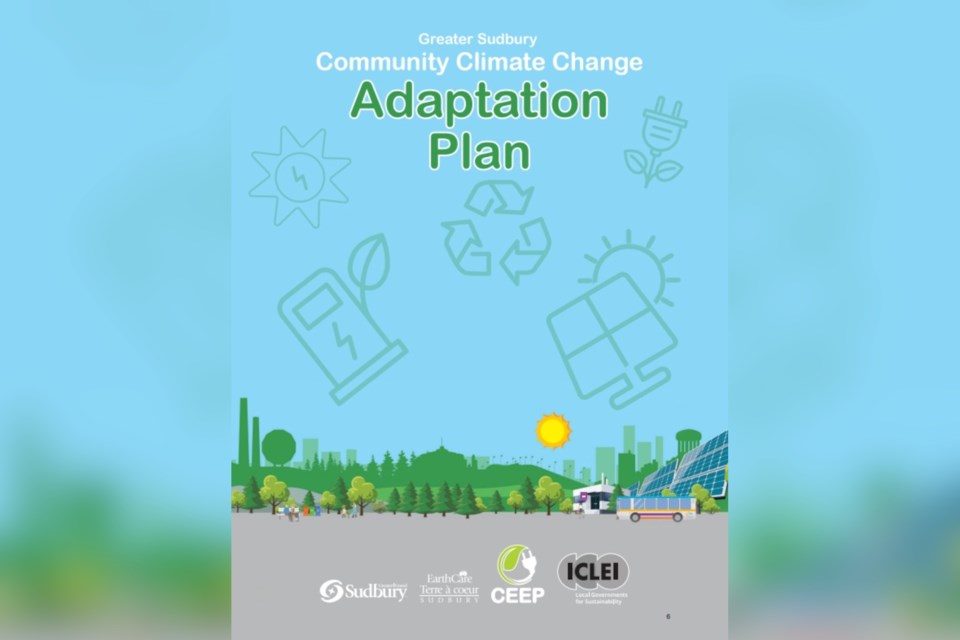Securing a more complete breadth of climate change response, Greater Sudbury’s elected officials adopted a Community Climate Change Adaptation Plan (CCCAP) last week.
The plan joins the Community Energy and Emissions Plan (CEEP) to provide a set of “guiding documents of climate action for the City of Greater Sudbury,” city climate change co-ordinator Jennifer Babin-Fenske explained.
Whereas the CEEP centres on mitigative measures for Greater Sudbury to do their part to prevent climate change, such as achieving net-zero emissions by 2050, the CCCAP centres on adaptation — “managing the unavoidable.”
“Adaptation is trying to prepare for what’s happening — adapting and becoming more resilient, planning for floods, droughts, power outages for example,” Babin-Fenske said.
Joining the effort is city council’s decision last week to create a climate resistance contract position “to lead the implementation” of both the CEEP and the CCAP.
This effort moves forward on a campaign pledge Mayor Paul Lefebvre made during last year’s campaign to have the city set achievable targets along the path to becoming net-zero by 2050.
The intent, he explained on election night 2022, was to set goals that are “attainable in the short term” along the path toward the ultimate goal so the city can better benchmark their progress.
During last week’s meeting, Lefebvre called the CCCAP and the creation of a climate resistance contract position as “a great step forward.”
Per an amendment by Ward 9 Coun. Deb McIntosh, the new position will be paid for by existing funds this year, with subsequent years’ funding to be debated during 2024-25 budget talks.
As for adapting to the changing climate, the CCCAP, now formally adopted, will factor into various decisions of city council across all departments, just as the CEEP presently does.
In every report to city council, a section highlighting environmental impacts falls under a heading, “Relationship to the Strategic Plan, Health Impact Assessment and Community Energy & Emissions Plan (CEEP).”
As a result of their adoption of the CCCAP, climate change adaptive measures will now also be included.
Adapting, Babin-Fenske explained, “is preparing, planning, providing options and continuously adjusting to become more resilient.”
McIntosh flagged this year’s spring flooding as an example of something that could have been proactively addressed under the CCCAP.
“There’s nothing we can do about it (now), but we could have not let them build 20 years ago in that area,” she said.
Another example is the emerald ash borer, Ward 8 Coun. Al Sizer said, referencing an invasive species detected in southern Ontario several years ago that has been recently wreaking havoc on Greater Sudbury’s ash tree population.
“It will impact virtually every ash tree in our urban forest,” city Growth and Infrastructure manager Tony Cecutti said, adding that staff members are currently putting a report together to present to city council on the matter.
Cecutti noted that although the CCCAP further formalizes the city’s prioritization of climate change adaptation measures, staff has already held it as a priority following city council’s direction.
During last week’s presentation, Babin-Fenske highlighted the very real threat of climate change by citing historical temperature data.
From 1950 to 1980, there were an average of three days per year in which the temperature exceeded 32 C (and a maximum of five days). Between 1981 and 2014, the average was 5.2 days, with a maximum of 11 recorded in 2013.
Drawing information from climateatlas.ca, she noted the date of the last spring frost is anticipated to arrive earlier and the mean annual precipitation is anticipated to increase.
According to her presentation to city council, climate change impacts could include such things as health impacts (heat, air pollution), wildfires, pest and disease epidemics, lakes having more ice-free days, extreme weather (storms, flooding, power outages), impacts on food production and impacts to the economic sector.
The city’s CCCAP was developed by city staff, Atikameksheng Anishnawbek, Wahnapitae First Nation and community stakeholders who were “engaged to collectively identify key vulnerabilities for our region related to climate change impacts,” according to the document.
“The changing climate presents us with an uncertain future, but by developing this CCCAP, Greater Sudbury will be better prepared and resilient to changes that may come.”
Baked into the document are various broad goals under six overarching theme areas, including built environment, natural environment, local economy, cultural and social cohesion, community health and well-being and enabling actions.
Under “built environment,” for example, actions include such things as improving the resiliency of roofs to heavy snow and extreme weather, updating drinking water source capacity models and source protection actions with current climate impact predictions, and improving the performance and resilience of roads, culverts and bridges under extreme weather conditions.
The top five risks related to climate change, according to the document, are:
- Changes in seasonal temperature will lead to shifting eco-regions for flora and fauna communities and can lead to increased spread of invasive species.
- Increased freezing rain events may increase hazardous road accidents.
- Increased freezing rain events may increase damaged power lines from fallen tree limbs.
- Increasing number of warm days and decreasing number of cold days will adversely impact air quality.
- Increased rain events in the summer may lead to urban flooding, especially in basements in low-lying areas.
The full text of the Greater Sudbury Community Climate Change Adaptation Plan can be found by clicking here.
Tyler Clarke covers city hall and political affairs for Sudbury.com.
